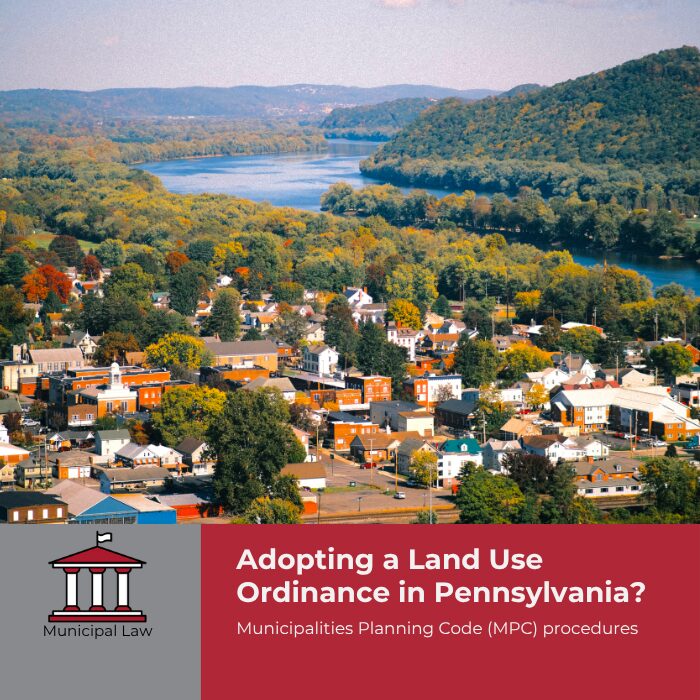Procedural Requirements for Adoption of a Land Use Ordinance in Pennsylvania
Written by Andrew Miller

In Pennsylvania, there are key procedural differences in the adoption of a land use ordinance versus a general health and safety ordinance. Municipalities and developers alike must understand and assure compliance with the requirements for adoption of land use ordinances. The requirements are particularly relevant for developers of new and emerging land uses where new ordinances and amendments may be adopted to regulate the uses at any time. Data center developers, solar developers, wind project developers and other developers of emerging uses should therefore pay close attention to the rules.
The power to regulate land use arises from the Pennsylvania Municipalities Planning Code, 53 P.S. §§ 10101-11202. The MPC, as we commonly call the code, requires local municipalities to conduct a public hearing to inform the public and take public comment prior to adoption. The public hearing must be conducted at a public hearing pursuant to public notice. Public notice under the MPC requires notice to be published at least two times in successive weeks in a newspaper of general circulation with the first advertisement not more than 30 days prior to the public hearing and the second notice not more than 7 days prior to the public hearing. The term “successive weeks” is not defined in the MPC, but is defined in the Statutory Construction Act of 1972, 1 Pa.C.S. §§ 1501– 1991. The phrase “successive weeks” in reference to publishing of notices, requires that weeks “shall be construed as calendar weeks [and the] publication upon any day of such weeks shall be sufficient publication for that week, but at least five days shall elapse between each publication.” 1 Pa.C.S. § 1909. Note, however, if an objector has actual notice of the ordinance, the Commonwealth Court has held that four days in between notices to be sufficient. See In re McGlynn, 974 A.2d 525 (Pa. Cmwlth. Ct. 2009). In addition to the published notice of the public hearing, the public meeting where the hearing is conducted must be advertised as a public meeting and agenda properly posted in accordance with the Pennsylvania Sunshine Act.
Land use ordinances must also be submitted to the local planning commission and county planning commission for review and recommendation at least 30 days prior to the public hearing. Note that the MPC does not require any action be taken by the planning commissions, but only the submission of the proposed ordinance for opportunity to review and comment. If the ordinance involves the rezoning of land, then notice of the public hearing must also be posted on the affected tract of land and mailed at least 30 days in advance “by first class mail to the addressees to which real estate tax bills are sent for all real property located within the area being rezoned, as evidenced by tax records within the possession of the municipality.” 53 P.S. § 10609. Note that a landowner (including mineral rights owners) has a right to request specific public notice be mailed or delivered electronically in accordance with 53 P.S. § 10109.
The ordinance itself must also be advertised in the standard manner for ordinances by publishing a summary of the ordinance and date for consideration at a public meeting no more than 60 days and no less than 7 days prior to the public meeting where the ordinances will be considered for enactment. If a summary is published, a full copy of the ordinance must be available for review at the newspaper and a certified copy of the full ordinance must also be submitted to the county law library or other designated county office for public review.
The notice of intent to consider and adopt an ordinance may be combined with the notice of public hearing. Following the public hearing, the municipal officials may act on the ordinance. If the ordinance is adopted, a certified copy of the adopted ordinance must be sent to the county planning commission or county governing body if no planning commission exists within 30 days after enactment. A certified copy should also be submitted to the county law library.
In addition to all the pre-enactment procedures for a land use ordinance, the MPC has an option post-enactment notice procedure in 53 P.S. § 10109 that allows the municipality or an interested party to advertise notice of the enactment of an ordinance or any decision of the municipality in a land use case. Any objectors to the ordinance or decision must bring their claims within 30 days after publication fo the last notice. Failure to do so bars the claims except in the case of an unconstitutional deprivation of due process which is a very difficult standard for an objector to establish. We always recommend following this optional procedure where there is the possibility of any irregularity in any ordinance advertisements or adoption.
Strict compliance with the procedural requirements for the adoption of a land use ordinance is critical for both the municipality and developers. Date center developers, solar project developers and wind project developers should always closely monitor the notices provided for ordinances that will affect them. Irregularities lead to uncertainty and possible challenges to projects that could prove costly or even fatal.
MPL Law Firm’s land use attorneys help municipalities, developers, and energy project teams ensure ordinances are properly adopted and legally defensible. Contact MPL to review your ordinance or discuss your project’s compliance strategy.


